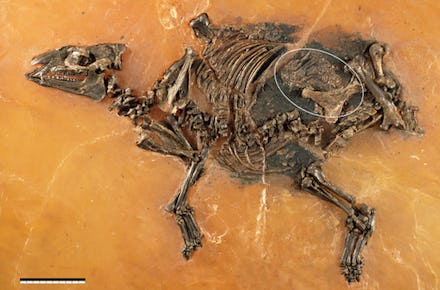48 Million-Year-Old Horse Fetus Found in Germany Is the Oldest Fossil of Its Kind

Researchers have discovered a horse-like fetus that's more than 48 million years old, according to a study published Thursday in Plos One, making it the oldest preserved uterus in history. The fossil was discovered near Frankfurt, Germany, in 2000, and was kept surprisingly intact, as researchers used scanning electronic microscopy and high resolution micro-X-rays to better understand its reproductive system.
The Senckenberg Research Institute in Frankfurt and Naturhistorisches Museum in Basel, Switzerland, teamed up for the joint study, according to a press release. "The well-preserved condition of the fossil allowed the researchers to reconstruct the original appearance and position of the fetus," the release notes. "They estimate that the mare may have died shortly before birth, but don't believe the death was related to birth."
The fossil comes from a horse predecessor that was much smaller than present-day horses, standing only about a foot tall, the Los Angeles Times reports. While the remains were found in near-perfect condition, the skull was the only portion of the was crushed and required complete restructuring.
Jens Lorenz Franzen, along with fellow researchers from the institute and the Switzerland museum, were essentially able to reconstruct the original form of the fetus, discovering soft-like tissues and other well-preserved parts of the fossil, including the placenta and a broad uterine ligament.
The rare intact fossil is revealing interesting facts to the science community. Researchers note the horse-like species, technically referred to as the European eocene equoid Eurohippus messelensis, actually had a well-developed reproductive system during the Paleocene epoch.
The findings follow last month's discovery of a new species in human lineage, called the Homo naledi, in a South African cave. September's discovery was the largest sample of hominin fossils ever found in an African site, according to the New York Times.